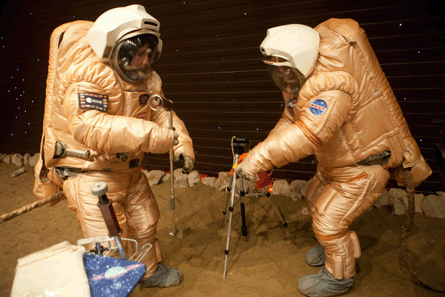When George Bush declared in 2004 that US astronauts would resume Moon missions by 2015 and set off for Mars by the mid-2020s, the then-US president set NASA two tremendous challenges. Both programmes failed the financial challenge and were axed by Bush's budget-constrained successor, Barack Obama.
Whether the technical challenge ever will be met is an open question. Going to the Moon is possible, as proved by the Apollo missions 30 years earlier. Going to Mars, however, is far more than an extended Moon jaunt and not all experts believe it is a realistic ambition. Daunting challenges abound, from carrying enough fuel for a return journey, or making return-trip fuel, to protecting the crew from solar radiation peaks or the fact that no life-support system yet devised is capable of operating for 18 months or longer with no link to Earth.
But the European Space Agency and Russia's Institute of Biomedical Problems (IBMP) decided to try to answer one key question about a manned Mars mission - could the crew cope, psychologically, with the stress of living and working in a small spacecraft long enough to get there and back?
The result is one of the more profound - or just weird - experiments in the history of spaceflight. And, so far, the answer seems to be "yes", more or less.
 |
|---|
 |
© ESA |
A year ago, three Russians and two Europeans and one Chinese closed the hatch on a simulated "spacecraft" at the IBMP, near Moscow, and pretended to set off for Mars.
Their "ship" - four sealed interconnected cylinders with a total volume of 550m3 (19,400ft3) with private cabins, where they live and work very much like astronauts on the International Space Station - mimics every aspect of an interplanetary flight, as far as possible without flying into space.
Since "launch", they have simulated undocking from an orbital assembly laboratory, transfer to heliocentric orbit towards Mars, shifting to spiral orbit towards Mars, entering circular orbit around Mars and finally, in February, entering a landing module to explore the Martian surface (in "spacesuits" inside a big hall that was built to look like the Martian surface) before ascent, quarantine, docking with their interplanetary craft, end of quarantine, return to habitation module and the beginning of their return towards Earth.
At present, they are still so far from "Earth" as to be simulating a communication delay in talking to the "ground". On 5 November, the crew will "land" back on Earth.
Crew diaries suggest that they may make it home without incident. "Wow, it's already been a year," writes Diego Urbina, one of the two ESA crew members. "One way to visualise it is if you think of what you were doing exactly one year ago, and then picture yourself living in a windowless metal box from then."
Or, writes Urbina's European crewmate Romain Charles: "We still have five months ahead of us a lot of opportunities to make this trip to Mars even more special.
"We have a great crew and although our backgrounds are significantly different, we never had any conflicts between us. That's why I'm full of optimism for our last days in the Mars500 modules. We'll see you on the 5th of November when we'll land on Earth after our 520-day journey to the Red Planet, not before."
Source: Flight International



















